22 – January 2020
clustered | unclusteredLayers of Time in the Urban Landscape. Visions of Socialist Urbanity in Mitrovica
Pieter Troch & Thomas Janssens
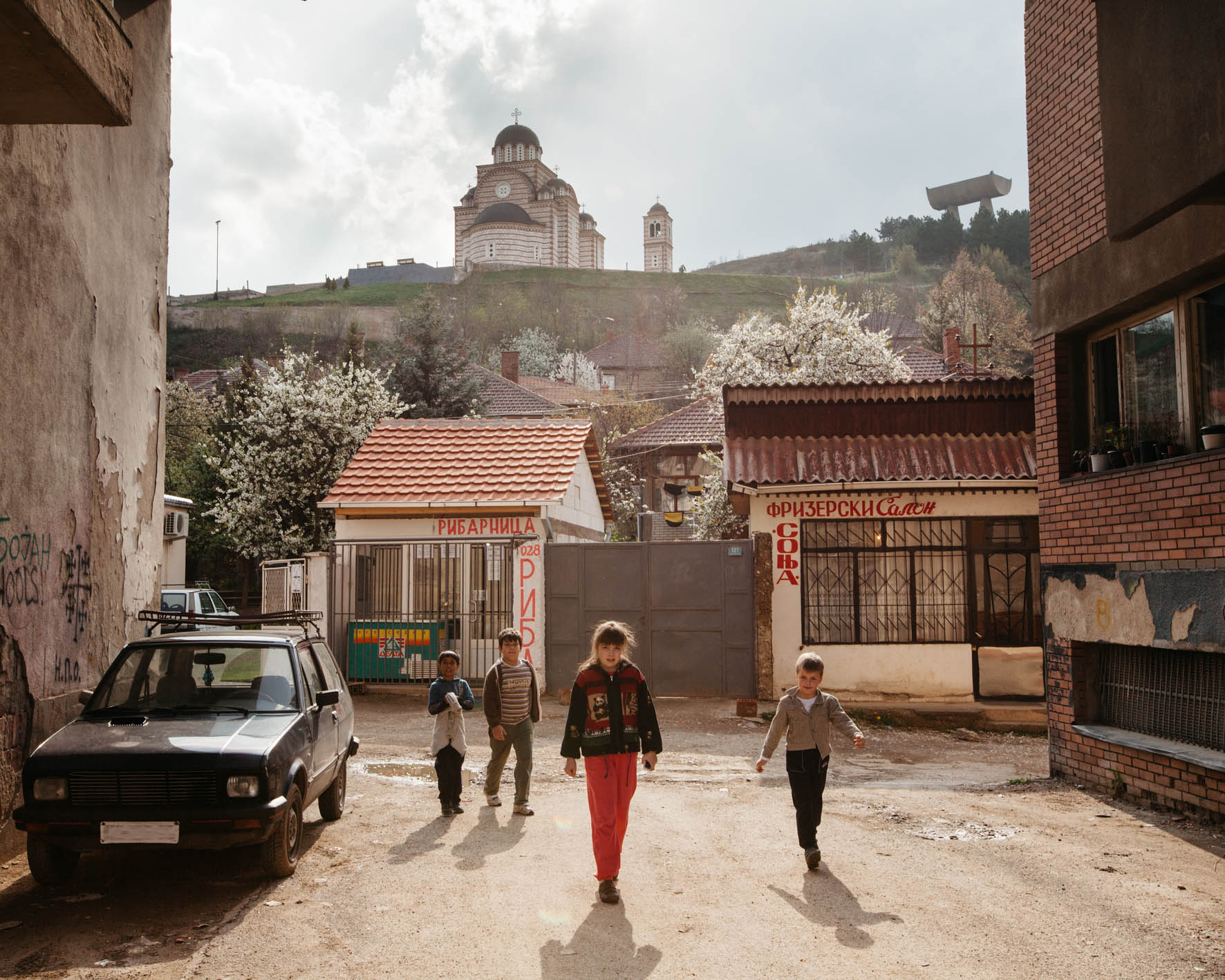
Book and preview available on www.jovis.de
This is the last cluster of a four-part publication series which derives from COLLATERAL's symposium ‘State of the Union’ that took place in Hasselt on the 3rd of May, 2019
a
clustered | unclusteredEurope from Its Fringes1
Pieter Troch
What does Europe mean from the perspective of its fringes? What does it mean to be European for people considered backward and not-quite European "Others" within the margins of the European cultural and political space?2 This contribution looks for answers in the city of Mitrovica in northern Kosovo.3 The city serves as the emblematic fault-line city in the ongoing geopolitical and ethnopolitical dispute over the status of Kosovo.4 After the war of 1998-99 and riots in 2000 and 2004, the Ibër River developed into the natural dividing line between the Serb-dominated northern part of the city and the predominantly Albanian southern half. The northern part de facto falls under the authority of the Republic of Serbia and is the urban stronghold for continuing Serbian claims to Kosovo. Although Kosovar institutions are present in the North as well, these have been successfully usurped by local politicians faithful to Belgrade. The southern part of the city is firmly entrenched in the independent Republic of Kosovo. In the framework of the EU-mediated dialogue between Serbia and Kosovo, the physical barricades between both parts of the city have been removed, and ongoing reconstruction work at the central bridge aims to guarantee freedom of movement and goods and reopen the city centre as a place for social encounters.

Europe is a key determinant for many aspects of contemporary urban life in Mitrovica. The European Union invests heavily both financially and politically to establish political stability – under the banners of democracy and rule of law, but with no clarity on the ultimate status of Kosovo – and to promote transition from a worn-torn, socialist plan economy to a functioning market economy. The EU is an important political actor and arguably more than the ethnopolitical rival on the other side of the river the main sounding board for local and national politicians. Almost ritualised subscriptions to European values of democracy and rule of law – in combination with blaming the other for non-European ethnonational and/or religious extremism – help to secure political capital. EU development funding is the city’s economic motor, in addition to remittances from the diaspora working and living in Western Europe. Infrastructure projects by definition display the EU flag and the amount of funding. An astonishingly wide plethora of local NGOs compete for EU funding, providing some of the most sought-after opportunities for employment for local educated youth.
The European Union, to be sure, has achieved major results in Mitrovica and Kosovo more generally. It has succeeded in stabilising relations between Albanians and Serbs, and between Serbia and Kosovo. Crossing the Ibar in Mitrovica is no longer a risky act. However, it is an ethnopolitical act, and in this regard, the role of the EU should be critically looked at. European development politics consolidates and spatialises the ethnopolitical division that led to and crystallised during the war of the 1990s.5 Local government is divided along ethno-spatial lines, as Serbia and Kosovo provide parallel public services in healthcare, education, and social assistance. The EU talks with local politicians as ethnic representatives. The reconstruction of the area around the central bridge has, in fact, established two city centres. Local NGOs are overwhelmingly ethnically defined and receive funding and support as such, even if they implement projects aimed at fostering ethnic tolerance and dialogue. Obviously, you need clearly defined and delineated ethnic groups and actors to start promoting ethnic tolerance and dialogue. At the local level, the EU in Kosovo applies the rule that also determines its foreign policy: "Good borders make good friends". Of course, the EU does not carry the blame for the ethnic division in Kosovo, but its involvement keeps in place and consolidates some of the divisive patterns.
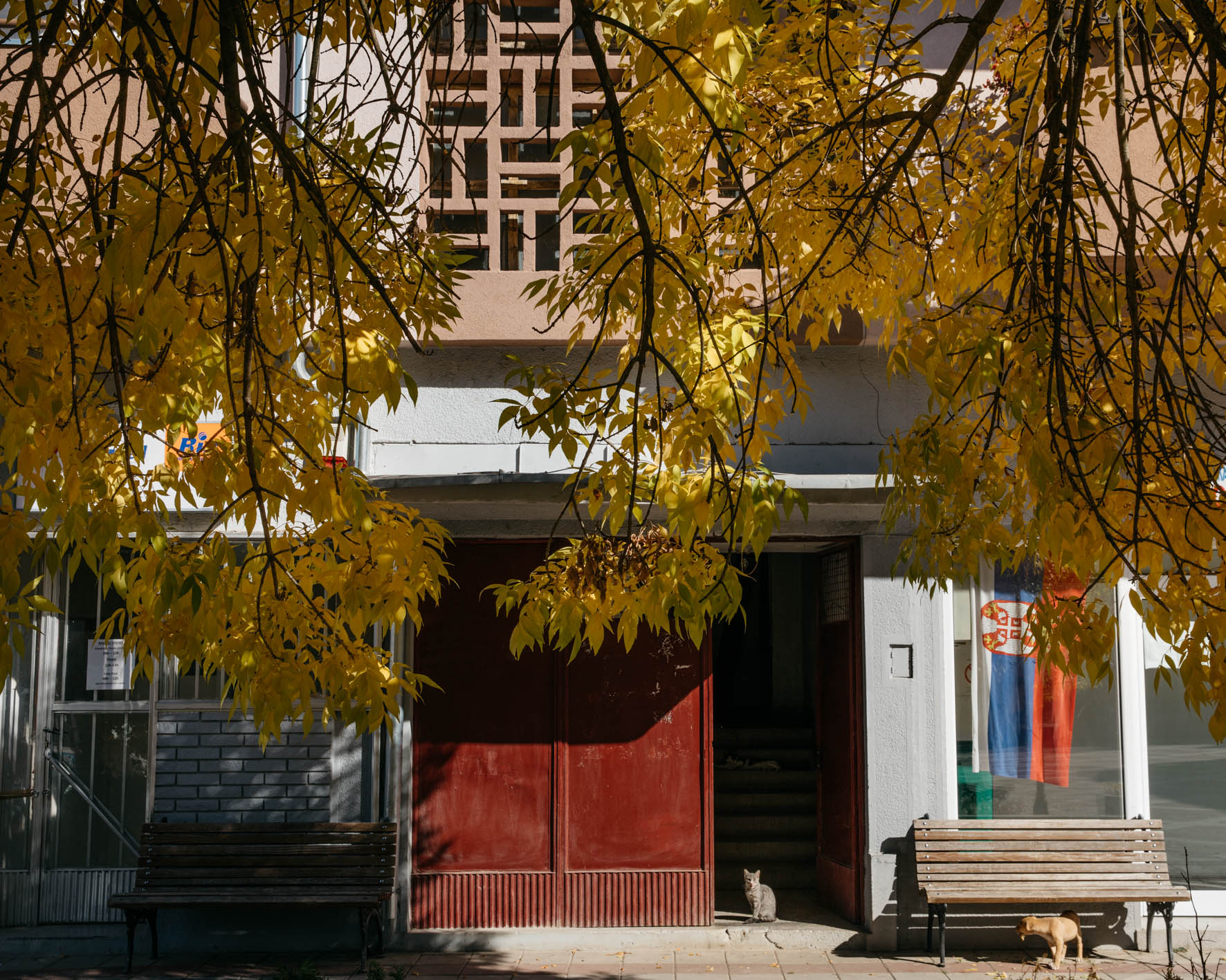
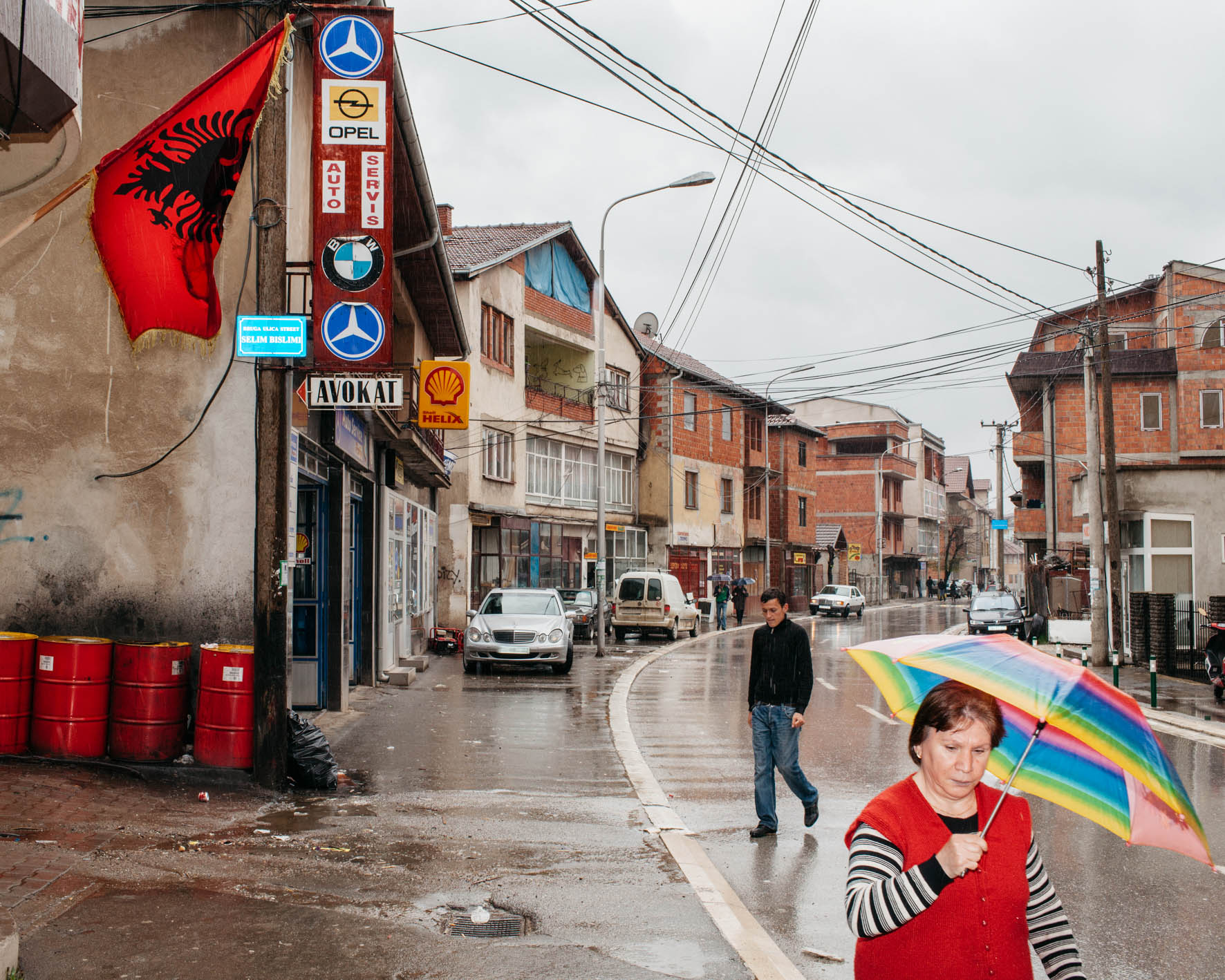
Alternative meanings of Europe are tucked away in urban layers beneath the divided city. When one stands at the central bridge, it is not only the barricades or flags that catch the eye. The residential buildings that look out over the bridge are typical examples of Socialist Yugoslavia’s modernist architecture. Bogdan Bogdanović’s monumental sculpture to the Partisan Miners feels remarkably a-national and out-of-place in the ethnically divided city, inscribing the city firmly and lastingly into the modernism of post-WWII Europe. These are landmarks of socialist urban planning, which took off from the late 1950s onwards and aimed to develop Mitrovica’s urban area into a compact, life-sized, orderly, and functional environment. It foresaw the complete transformation of the existing post-Ottoman trade town, which was criticised for being chaotic, backward, dysfunctional, and unhygienic – indeed, not-quite European. The new city would be characterised by order, advanced technical solutions to improve living conditions, and efficient zoning to guarantee industrial production, public life, residential functions, and recreation.6
To be sure, very little of these ambitions came true as anticipated. Massive rural-to-urban migration surpassed the urban capacities and led to urban sprawl and informal homebuilding. Limited political and financial resources as well as changes in urban development policy cut short the reconstruction of the pre-socialist city and the extension of typical socialist residential estates. Typical high-rise residential buildings soon lost their appeal among the population. Heavy lead industry threatened the quality of life in substantial ways. The ideal of socialist equality collided with socio-economic inequality and socio-spatial differentiation in the city. Yet, the socialist "scaffold" and the modernist temporalities of progress it carries with it continues to structure the city in fundamental ways and is remarkably flexible in obtaining new meanings under post-conflict and post-socialist conditions.7


Again, the Partisan Miners’ Monument can serve as a starting point. The monument’s original copper cover has not survived transformation. The park surrounding the monument is poorly maintained, although the EU has invested in a walking trail, and it takes a remarkably difficult and lonely hike to actually reach the monument. Its former grandeur is further challenged by the more recent Orthodox church, which towers over the Serbian northern part of the city to claim ethnoreligious ownership (Serbs are Orthodox, Albanians are mostly Muslim in Kosovo). And still, the monument – be it in a decayed state – continues to occupy a central position in the urban landscape and portrays some of the future-oriented faith of the 1960s and early 70s.
Similar ambiguous overlaps of progress and ruination define other built carriers of modernism in the city. Two huge industrial ruins prominently figure on the edges of the cityscape. In the north, an iconic smokestack towers above the valley. A vast dilapidated complex welcomes visitors who enter the city from the south. Both zones were part of the Trepça mining, metallurgical, and chemical industry enterprise, the catalyst behind the radical transformation of the city throughout the twentieth century. All inhabitants of Mitrovica, regardless of ethnicity, age, profession, and interests, put great stress on the magnificent role of Trepča for urban life. The social reach of Trepça went far beyond the gates of the enterprise. It financed housing, utilities, infrastructure, educational facilities, and health care in the city and supported sports and culture. Bogdanović’s monument indicates the symbolic centrality of mining in the city’s identity.
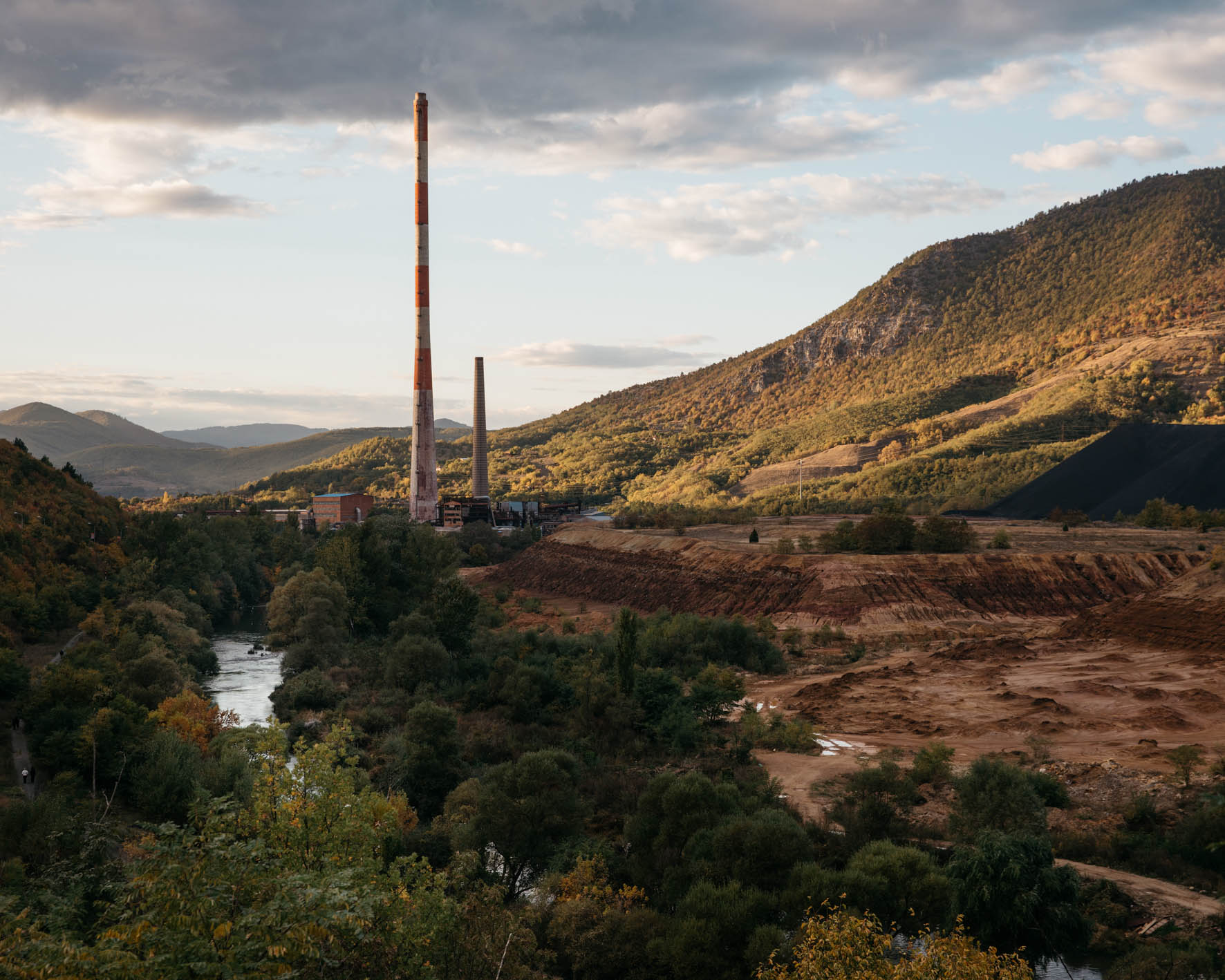
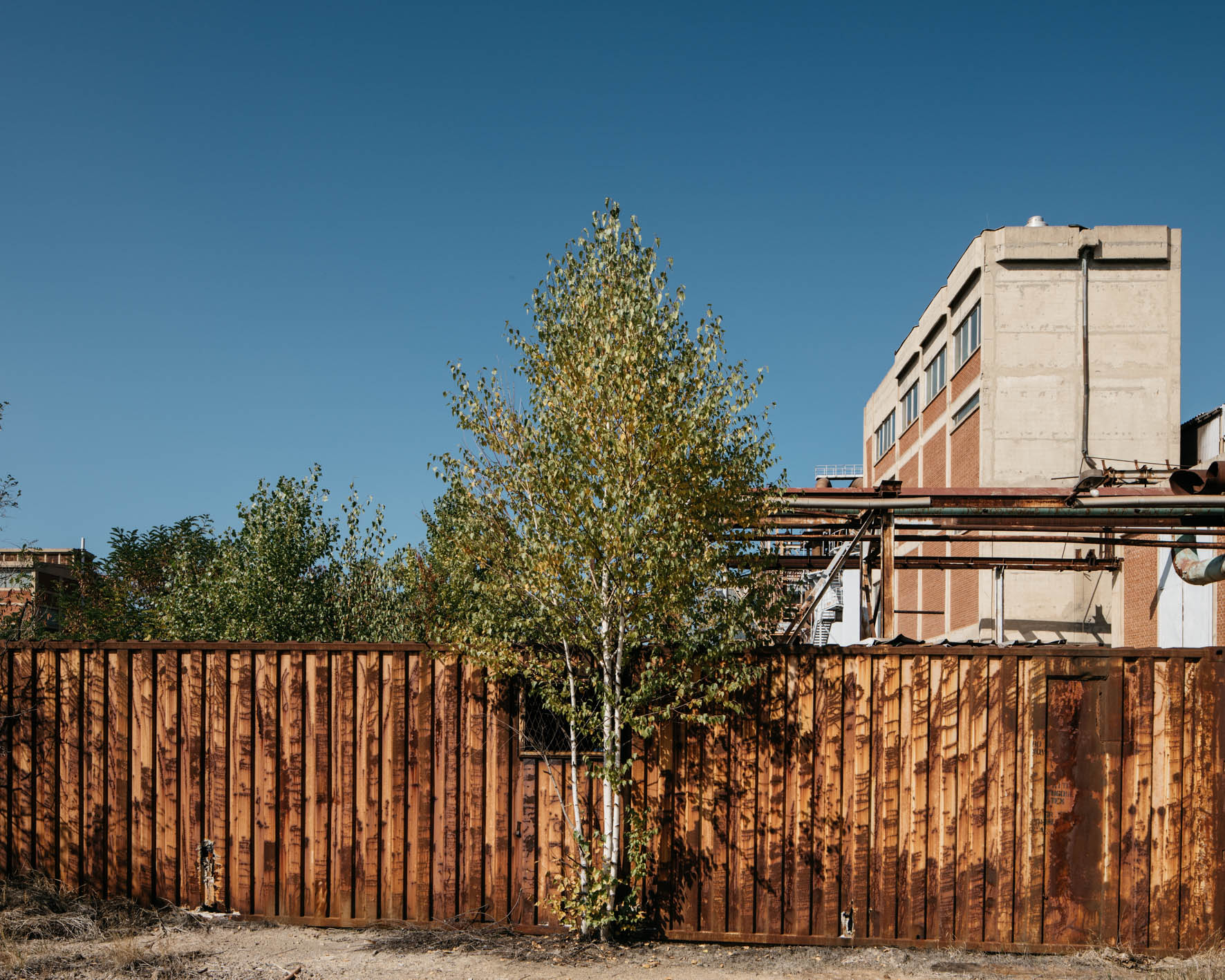
Once the spearheads of progress, these sites have relapsed into places of industrial ruination, which symbolise the despair of the deindustrialising society. They also suffered badly from destruction, damage, and armed conflict during the constant state of emergency and conflict in Kosovo in the 1990s. They are firmly inscribed in the dominant narrative of ethnopolitical division, as the ownership over Trepča is one of the major obstacles in the dialogue between Kosovo and Serbia. The northern complex is the seat of the Serbian heir to the enterprise, the southern complex represents Kosovo-Albanian claims. Both sites do not officially communicate with each other, but aim to influence geopolitical decision-makers like the EU. As a part of this particular mode of industrial communication, the industrial sites in the city remain formally operating. The operations are, however, performative. Most of the work that is going on takes place at the management level. The little production work has the character of ritualised performances of productivity. Workers sweep dust and hold meetings without real agenda points. Most of the time, they are merely present.8
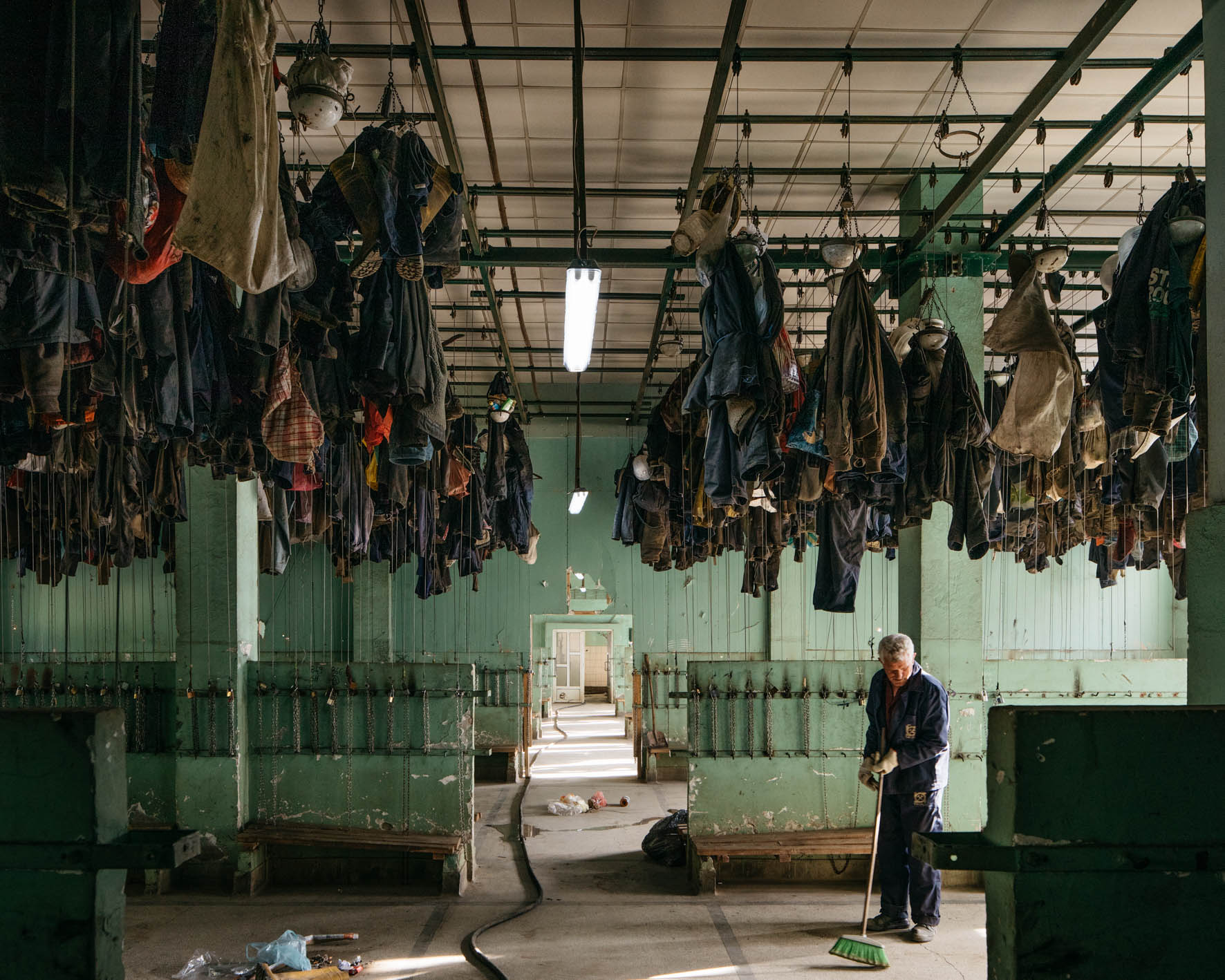
It would be misleading, however, to understand the industrial heritage of present-day Mitrovica – and that of the modernist city more broadly – exclusively in terms of loss and despair. The locals’ pride of the industrial city is not merely passive nostalgia for a lost age and an expression of their inability to master post-socialist transition. For one thing, the mining enterprise is still materially present. A large part of the population of Mitrovica continues to live in houses constructed and financed by Trepča. The education, healthcare, sports, and cultural facilities that are central to the urban identity of the city are all associated to the enterprise. Many of the urban inhabitants were first-generation rural-to-urban migrants, who intimately relate the built environment of the mining city to their own lived experience of normalcy and life cycle prospects.9
The continuing formal operation of the industrial sites, in spite of the obvious signs of industrial decline, symbolises the ambiguous interplay of progress and ruination in the city as a whole and in the minds of its people. Remaining workers are clearly struggling with feelings of devaluation and demoralisation as they have become actors of socialist productivity in a factory that produces not even a fraction of the millions of tons it used to produce in its heyday. However, at the same time, they share a strong sense of attachment to these very sites of industrial production, which still herald the unfulfilled expectations of urbanisation and progress. The post-conflict setting also brings additional national meaning to the performativity of keeping industrial sites in operation, as it supports Serbian and Kosovan claims to the heritage and assets of Trepça, and more broadly, the heritage of urban modernity and progress.
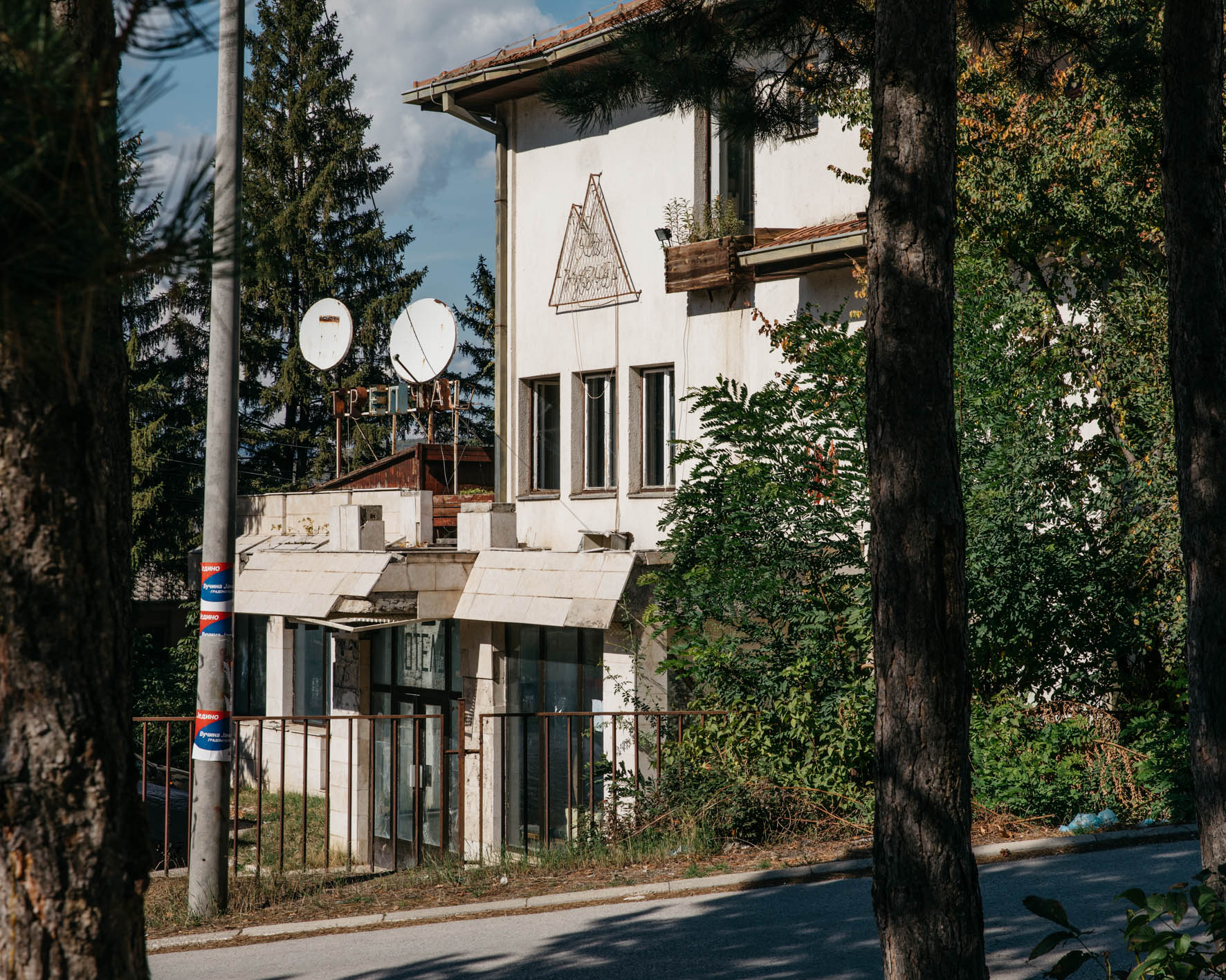

Beneath the surface of the divided city, the heritage of industrial production and accompanying urban development inscribes the city in an alternative Europe of progress and modernity. Indeed, socialist industrialisation was decisively modernist and European. Locals do not fail to tell me – of course guided by their assessment that I am European par excellence and thus well-placed to value such claims – that Trepča was a European and global industrial giant, trading all over the world (Socialist Yugoslavia was non-aligned between the Cold War blocks), and producing goods, experts, and culture of European esteem. Such visions of European modernity in the past contrast with the dominant contemporary perception of European integration as situated in the future and requiring transition and development, with assistance from outside. For many inhabitants, the current post-socialist transformation under EU auspices actually further distances the city from the Europe it firmly belonged to during the heyday of industrial growth.10 At the same time, both Europes interact, as becomes particularly clear from the seemingly contradictory fact that EU integration and conflict resolution actually consolidate the protracted performative functioning of socialist industry in the city.
Notes
- 1All pictures accompanying this text are by Thomas Janssens. A more elaborate selection of pictures along with a historical essay are published in the book Layers of Time in the Urban Landscape: Visions of Socialist Urbanity in Mitrovica (Berlin: jovis, 2018). The work was financially supported by the European Union’s Horizon 2020 research and innovation programme under the Marie Sklodowska-Curie grant agreement No 700759.
- 2Maria Todorova, Imagining the Balkans (Oxford: Oxford University Press, 1997).
- 3I use the Albanian and Serbian writing of place names in Kosovo interchangeably to avoid essentialising ethnopolitical division. In any case, the differences are mostly orthographic. Mitrovica is the same in Serbian and Albanian. The Serbian "Ibar" has the equivalent "Ibër" in Albanian, "Trepça" in Albanian is "Trepča" in Serbian.
- 4The best concise history of Kosovo is: Oliver J. Schmitt, Kosovo: Kurze Geschichte einer zentralbalkanischer Landschaft (Vienna: Böhlau, 2008).
- 5Carl T. Dahlman, "Bordering on Peace: Kosovo and the Decentralisation of Ethnopolitical Competition", L’Espace Politique 33, no. 3 (2017); Vjosa Musliu and Jan Orbie, "The International Mission in Kosovo: What is in a Name?", European Foreign Affairs Review 19, no. 3 (2014): 411–28.
- 6On Socialist Yugoslav architecture, see Vladimir Kulić, Maroje Mrduljaš, and Wolfgang Thaler, Modernism in Between: The Mediatory Architectures of Socialist Yugoslavia (Berlin: jovis, 2012). For a readable and personal appraisal of Communist urban architecture across Eastern Europe, see Owen Hatherley, Landscapes of Communism: A History through Buildings (London: Penguin, 2016).
- 7On the long afterlife of the socialist scaffold, see Kimberly Elman Zarecor, "What Was So Socialist about the Socialist City? Second World Urbanity in Europe", Journal of Urban History 44, no. 1 (2018): 95–117.
- 8For a case-study of ritualised performances of productivity in former state enterprises in Yugoslavia, see Ivan Rajković, "For an Anthropology of the Demoralized: State Pay, Mock-Labour, and Unfreedom in a Serbian Firm", Journal of the Royal Anthropological Institute 24, no. 1 (2018): 47–70.
- 9For an anthropology of a post-Soviet mono-industrial town, see Jeremy Morris, Everyday Post-Socialism: Working-Class Communities in the Russian Margins (Basingstoke: Palgrave Macmillan, 2016). See also Alice Mah, Industrial Ruination, Community, and Place: Landscapes and Legacies of Urban Decline (Toronto: University of Toronto Press, 2012).
- 10Tanja Petrović, Nostalgia for Industrial Labour in Socialist Yugoslavia, or Why the Post-Socialist Affect Matters", paper on international conference Nostalgia on the Move (Belgrade, 2017). Available on Academia.edu.
b
clustered | unclusteredKosovo: the ‘good’ war, the ‘unruly’ North1
Jaume Castan Pinos
In November 2019, NATO launched a self-glorifying Youtube video titled “NATO and Kosovo: The evolution of KFOR”2. The video, which is technically impeccable, describes the complex conflict in Kosovo in a simplistic Manichean fashion. Needless to say, NATO are the ‘good guys’ who fought (and won) a ‘good war’. The epic Hollywoodesque narrative, however, fails to address some significant wrinkles. For instance, it does not mention that 81% of the victims3 occurred during or after NATO’s Operation Allied Force bombing campaign, or that most of the refugees and internally displaced also fled after that military intervention. Further, the video omits the inability of the transatlantic organization (through its KFOR mission), which was in charge of security and policing after June 1999, to prevent reverse ethnic cleansing committed against minorities (Serbs, Roma and others) and to punish the perpetrators of such crimes. Although it does acknowledge that “Mitrovica/Mitrovicë is a reminder that there is still tension between Kosovo’s different ethnicities”, a cynical reader may conclude that this mention is instrumentally used to justify that its own presence is still needed in this territory of South-East Europe.
Let’s now turn our attention to the north of this city and to the adjacent municipalities (Leposavić, Zvečan, Zubin Potok) which constitute the informal 1,000km² region of ‘Northern Kosovo’, where Serbs represent a solid majority, in contrast with the south of the city which is populated mostly by Kosovo Albanians. Since its inception in 2008, the Kosovo state has struggled to gain legitimacy from the Serbian community in Kosovo, particularly north of the Ibar river, where the contestation against Kosovo statehood has been very explicit. In order to address the lack of legitimacy of the Kosovo state, several strategies – both coercive and co-optative – have been put in place by Prishtina and its international backers. Among the co-optative ones, the most relevant has probably been the emphasis on Kosovo being a multi-ethnic state, a principle which is included in several articles of the Kosovo Constitution, adopted in 2008. According to Landau,4 this emphasis on multi-ethnicity or on being a “state of communities” had a two-fold objective: on the one hand, it is aimed at gaining international legitimacy and, on the other, at persuading the Serbian community to buy-in the idea of the Kosovo state. Nearly 12 years after declaring its independence, Kosovo does not seem to have fully achieved any these two goals.
Persuading the Kosovo Serbs to love, integrate or even ‘accept’ the new state is not an easy task. For starters, after NATO’s intervention, 226.418 Serbs (and Roma) fled Kosovo, according to figures from Kosovo’s Ministry for Community and Return,5 and as of December 2019 most of them have not returned. Kosovo Serbs have therefore been on the losing end of the Kosovo conflict, in terms of demographics but also in political terms; the state they identified with was forced to withdraw from Kosovo in June 1999 and international institutions they did not trust filled the power vacuum (1999-2008). To make matters worse, international institutions (which claim to be neutral) paved the way for a new state which they perceived as antagonistic to their interests, to the extent that many members of the Serbian community view it as the final nail in the coffin for the presence of Serbs in Kosovo. In addition, as Erin Jenne argues, Kosovo Serbs have been “the target of continual harassment and discrimination in post-war Kosovo”6 which culminated in the anti-Serb riots of March 2004.
Unsurprisingly, from the Kosovo government perspective, the ‘North’ is perceived to be unruly and disloyal. In the past, Kosovo governments have demanded KFOR intervention in Northern Kosovo to restore its authority. Attempts to intervene by international organisations to enforce Prishtina’s rule have used force, including the deployment of NATO armoured vehicles in civilian areas, and have been violently confronted by local Serbs. In 2011, for example, the deployment of police and customs officers from the Kosovo government in Northern Kosovo was met with blockades and barricades – which lasted for three years –, erected by local Serbs who perceived governmental forces as hostile. In addition, border posts were burned down and shots were fired at KFOR troops. More recently, in May 2019, an operation carried out by Kosovo’s Special Forces to allegedly fight organised crime in Northern Kosovo was heavily criticised by Belgrade’s government representative in Kosovo for being aimed at intimidating and causing fear to local Serbs.7 It is therefore possible to conclude that Mitrovica and its surrounding Serbian-dominated municipalities continue being an unsolved issue, a wrinkle for the Kosovo government but also for its Western backers.
This leads us to reflect upon the consequences of border transformations, in our case the internationally-led creation of a new state, for local contexts. The city of Mitrovica is a very illustrative example of how geopolitical and territorial transformations have a direct impact on local communities.8 One of the most visible manifestations of this is that this city is today, in the post-intervention era, more divided – urbanistically, politically, socially, culturally and mentally – than it ever was. The tentative lesson is that cities are not immune to wider ethno-territorial disputes, quite on the contrary. The traditional understanding is that while cities may not be the main reason triggering a conflict, they often suffer the negative effects of it in terms of destruction, ethnic displacement and urban reconfiguration. Urban segregation scholars have argued that cities are transformed into “a battle zone for larger proxy wars initiated and orchestrated by agents whose interests extend beyond the municipal boundaries”.9 In the case of Mitrovica, however, the city is not simply the victim of a wider conflict but also a cause for the aggravation of that wider conflict. In other words, cities have agency and such agency is not always laudable.
To conclude, the reason why North Mitrovica and its neighbouring northern municipalities belong to the state/parastate of Kosovo is due to power relations which were created in the aftermath of NATO’s intervention. If these power relations change, the door will be potentially open for further territorial transformations in this region. Like it or not, that is the way international politics very often works.
Notes
- 1 Some parts of this article are based on the book Kosovo and the Collateral Effects of Humanitarian Intervention (Routledge, 2019).
- 2 NATO, “NATO and Kosovo: The evolution of KFOR” (2019). Available at: https://www.youtube.com/watch?v=U2wyk1Hjda0 (accessed 29.11.2019).
- 3 According to data from the Kosovo Memory Book (2015). Available at: https://www.kosovskaknjigapamcenja.org/?page_id=48 (accessed 29.11.2019).
- 4 Dana Landau, “The quest for legitimacy in independent Kosovo: the unfulfilled promise of diversity and minority rights”, Nationalities Papers 45, no. 3 (2017): 442–463.
- 5 Ministry for Community and Return, “Number of Refugees and displaced” (2019). Available at: http://mzp-rks.org/en/ (accessed 29.11.2019).
- 6 Erin K. Jenne, “The Paradox of Ethnic Partition: Lessons from de facto Partition in Bosnia and Kosovo”, Regional & Federal Studies 19, no. 2 (2009): 273–289.
- 7 RTS, “ROSU deploys in north Kosovo, Vucic orders full combat alert”, N1, 28 May 2019. Available at: http://rs.n1info.com/English/NEWS/a487168/RTS-ROSU-deploys-in-north-Kosovo-Vucic-orders-full-combat-alert.html (accessed 29.11.2019).
- 8 Jaume Castan Pinos, “Mitrovica: a city (re)shaped by division”, Éamonn Ó Ciardha and Gabriela Vojvoda (eds.), Politics of Identity in Post-Conflict States. The Bosnian and Irish Experience (Abingdon: Routledge, 2016), 128–142.
- 9 Jon Calame and Esther Charlesworth, Divided Cities: Belfast, Beirut, Jerusalem, Mostar, and Nicosia (Philadelphia: University of Pennsylvania Press, 2009).
c
clustered | unclusteredKameni Govornici
The Stone Speakers (2018)
Igor Drljača
Exerpt from The Stone Speakers (2018) — Canada / Bosnia&Herzegovina - English, Bosnian, Croatian, Serbian - 92 min -Color - DCP - 1.85 - 5.1
Director's Statement
In The Stone Speakers, I wanted to explore the relationship between recent tourist sites and attempts to create competing national narratives in post-war Bosnia-Herzegovina. These divergent narratives and the relationship between Bosnia’s ethnic groups continue to be a source of misunderstanding and tension. The tourist sites may appear to be innocuous enough, but all have underlying narratives which suggest an alternative Bosnian or regional history.
Today’s Bosnia-Herzegovina was created through the Dayton Peace Accords, which ended the civil war in the 1990s. The Accords enshrined the division of Bosnia’s population into three primary ethnic groups: Bosniaks, Serbs, and Croats. The process of ethnic cleansing during the war has also ensured that these groups largely live apart, with only some areas of the country retaining its pre-war multiethnic character. Little progress has been made since the war to address these divisions, and the country remains economically and socially unstable. Bosnia’s problems are worsening: it has the most severe unemployment rate in Europe and its population is rapidly declining.
The one bright spot is the country’s rapidly growing tourism industry. Bosnia’s unspoiled natural sites, and its rich history, have begun to attract tourists from all parts of the world. But the cultivation of the country’s tourist industry has not been immune to persisting divisions. Some of these tourist sites perpetuate competing narratives in curious ways, many of which can appear eccentric to outsiders. These eccentricities help to mask the ultimately perilous nature of the narratives perpetuated, as they continue to erode Bosnia’s fragile peace.
While the film was being made, events around the globe have increasingly become characterized by similar efforts to write and rewrite facts and history. Where Bosnia once stood out for its eccentricities, it can now bizarrely appear to be at the vanguard of a more global destabilizing movement, one which questions our deeply held beliefs about truth and fiction, right and wrong, and exclusion and belonging.Present-day Bosnia-Herzegovina is a country still reeling from the civil war in the early 90s. The Bosnian economy never recovered, and the country remains divided. In order to cope, many towns have transformed themselves into unique tourist destinations that bring together history, religion, politics and folklore. The tourist sites promoted are not only a reflection of people’s attempts to make a livelihood but are also a means to promote and establish competing narratives about the country’s past, present and future. The Stone Speakers explores four towns in Bosnia-Herzegovina through their tourism, slowly unravelling these competing narratives.
d
clustered | unclusteredKosovska Mitrovica, of een “verminkt Europa” in veelvoud
Kris Van Heuckelom
In zijn essaybundel Substancja nieuporządkowana (Ongeordende substantie, 2019) wijdt de Poolse dichter en essayist Adam Zagajewski enkele pagina’s aan het werk van de Belgische schilder en graficus Jan Vanriet. Zijn lofzang op het oeuvre van de Antwerpse kunstenaar begint hij als volgt:
Het overkomt me niet elke dag: in aanraking komen met het werk van een kunstenaar, schilder, aquarellist en tekenaar die in een ander land (België) geboren is en wiens passies, observaties en obsessies zo dicht bij de mijne liggen. De naam van de kunstenaar is Jan Vanriet en hij werd geboren in 1948 in Antwerpen. So what, zal de lezer zeggen, want is er iets banaler en — laat ons eerlijk zijn — comfortabeler dan geboren te worden op veilige afstand van oorlog en bezetting, ten westen van de Grote Grens, in de stad der diamanten? Beter in ieder geval dan geboren te worden in Lviv of in Warschau.1
In het vervolg van zijn exposé ontwaart Zagajewski – zelf geboren in Lviv in 1945 – in Vanriets oeuvre een grote gevoeligheid voor “thema’s die mij na aan het hart liggen, dat wil zeggen de thema’s van het ‘verminkte Europa’”2. Er zijn volgens de Poolse essayist op zijn minst twee redenen te bedenken voor die gedeelde artistieke en thematische affiniteit. Ten eerste werd Vanriet geboren in een familie die “de wonde van de twintigste eeuw, de wonde van oorlog (en oorlogen), het nazisme en de Holocaust”3 aan den lijve ondervonden heeft. Vanriets ouders waren tijdens de Tweede Wereldoorlog actief in het ondergronds verzet en overleefden de nazikampen. Ten tweede kwam de Antwerpse kunstenaar op jonge leeftijd in contact met een oudere vakgenoot uit wat Zagajewski “het tweede Europa” noemt, met name de Tsjech Pravoslav Sovak. Sovak werd al snel Vanriets artistieke mentor en vluchtte na de gewelddadige onderdrukking van de Praagse Lente naar West-Europa.
Een eerste belangrijk aspect van Zagajewski’s overwegingen is dat hij het “verminkt” zijn als een gedeelde Europese conditie voorstelt, en meer specifiek als de concrete uitloper van twee totalitaire systemen die de voorbije eeuw lelijk huishielden op het continent. Tezelfdertijd wijst zijn gebruik van de term “tweede Europa” op het diep ingeslepen (en terechte) besef dat de graad, de duur en de frequentie van de blootstelling aan die “verminking” niet overal even groot is geweest en dus ook niet dezelfde maatschappelijke en culturele impact heeft gehad. Met het onvermijdelijk simplificerende label “tweede Europa” doelt hij meteen ook op dat deel van het continent dat in de nasleep van de Tweede Wereldoorlog ten oosten van de “Grote Grens” (lees: het IJzeren Gordijn) kwam te liggen, in meerdere of mindere mate onder politieke en militaire controle van de Sovjet-Unie.4 Maar ook in de gedeelde ervaring van dat van buitenaf opgelegde communisme – of staatssocialisme, zoals sommigen het liever noemen – was er uiteraard heel wat lokale variatie en gradatie: terwijl een “ongebonden land” zoals Tito’s Socialistische Federale Republiek Joegoslavië een vrij liberale en autonome – want van de Sovjets onafhankelijke – koers kon varen, liepen sommige Oost-Europese satellietstaten heel nadrukkelijk in de pas van Moskou. Dat was bijvoorbeeld zo in het geval van Bulgarije, dat een tijdlang zelfs het statuut van “zestiende Sovjetrepubliek” ambieerde.
Wat hebben de beschouwingen van de in Oekraïne geboren Pool Zagajewski met de specifieke casus van Kosovska Mitrovica te maken? Meer dan je op het eerste gezicht zou denken. Neem alleen al Zagajewski’s geboortestad Lviv, die in de loop van de twintigste eeuw ettelijke keren van naam (en van staatkundig verband) veranderde: van het Oostenrijks-Habsburgse Lemberg over het Poolse Lwów tot het (thans nog steeds) Oekraïense Lviv. Zowel na de Eerste als na de Tweede Wereldoorlog werd de hele regio grondig geopolitiek herverkaveld, wat uiteindelijk leidde tot etnisch, linguïstisch en religieus relatief homogene gebieden (Zagajewski’s ontheemde familie kwam na de Tweede Wereldoorlog in het voormalig Duitse Gleiwitz terecht, dat intussen Pools grondgebied was geworden). De diverse staatkundige verbanden waar de regio Kosovo de voorbije eeuw deel van heeft uitgemaakt, zijn zo mogelijk nog talrijker. Alleen vond het proces van ethnic cleansing (en van geopolitieke herverkaveling) in dit gebied als het ware plaats in ‘uitgesteld relais’, met de (post-)Joegoslavische oorlogen van de jaren negentig als triest dieptepunt.
Het prefix “post” mag in de voorgaande zin dan wel tussen haakjes staan, maar vormt in feite de kern van de zaak. Zoals de Gentse slavist Pieter Troch terecht opmerkt in zijn uitgebreide inleiding bij de Mitrovica-fotoreeks van Thomas Janssens, hebben we in het geval van de Noord-Kosovaarse stad te maken met een “superimposition of ‘posts’”5. Het gaat, anders gezegd, om deels overlappende breuklijnen in de tijd, die samen de specifieke ruimte van de stad bepalen: post-Joegoslavisch en post-burgeroorlog, maar ook postcommunistisch en postindustrieel. Je zou je echter kunnen afvragen of je niet evengoed een soortgelijk historisch-fotografisch project – op het snijvlak van urbane sociologie en culturele antropologie – kan opzetten op een plek veel dichter bij huis, bijvoorbeeld in de al even deprimerende postindustriële setting van pakweg Charleroi of Seraing. Dat is zeker een optie (en het is ongetwijfeld al gebeurd), maar in een stad als Charleroi lijkt het stedelijke weefsel toch nog steeds beheerst te worden door een zeker gevoel van longue durée (lees: de gestage economische opgang van de Borinage sinds de negentiende eeuw en vervolgens de al even gestage neergang van de regio, in een globale context van de-industrialisering en neoliberale delokalisering. In het geval van het hedendaagse Mitrovica – dat onder het communisme officieel nog de naam “Tito’s Mitrovica” droeg – is de socio-economische en politieke context toch een pak ingewikkelder en gelaagder.
De verschillende “post”-lagen die de ruimte van de Noord-Kosovaarse stad karakteriseren, komen op ingenieuze wijze samen in de foto die de reeks van Thomas Janssens opent: een stel spelende kinderen loopt over een niet geasfalteerde, met plassen bezaaide straat in het noordelijke (Servische) stadsdeel.6

De twee wagens links op de voor- en achtergrond – respectievelijk een aftandse Yugo en een witte Renault 5 die in kennelijk ietwat betere staat verkeert – zijn stille getuigen van de post-Joegoslavische socio-economische transformatie. De twee huizenblokken die de vier spelende kinderen flankeren, etaleren mee de vergane glorie van het communistische urbaniserings- en moderniseringsproject. De twee kleine panden achter de kinderen met de opschriften “viswinkel” en “Kapsalon Sonja” in het Servisch fungeren op hun beurt als concrete voorbeelden van private ondernemingsdrang. Het logo van het Griekse Delta Foods, dat prominent op de groene diepvrieskist voor de viswinkel prijkt, getuigt echter ook van een internationale context. Op de Partizanenberg ten slotte, die op de achtergrond verrijst, ontwaren we twee bouwwerken die het turbulente – recente en minder recente – verleden van de stad in herinnering brengen: het Monument voor de Heldhaftige Mijnwerkers (opgericht in 1973) verwijst naar de lokale, inmiddels disfunctionele mijnindustrie, maar ook naar het aandeel van zowel Servische als Albanese mijnwerkers in de gewapende strijd tegen de nazi’s en hun bondgenoten tijdens de Tweede Wereldoorlog; de naar de patroonheilige van de stad vernoemde Servisch-orthodoxe Sint-Dimitrikerk daarentegen werd pas in de jaren 2000 gebouwd en is de concrete architecturale uitloper van de tweedeling Servisch / Albanees en christelijk / islamitisch die de stad na de door Servië gecontesteerde afscheiding van Kosovo tekent. Zodoende zit in dit ene kader de veelvuldige en aanslepende “verminking” van dit “tweede” deel van Europa vervat, op een manier die de erin figurerende kinderen amper zullen bevroeden.
Ten slotte nog deze bedenking: het is verleidelijk om na het bekijken van een indringende fotoreportage als die van Thomas Janssens in een soort centrum-periferie-denken te blijven steken, een dualistisch denken dat onze ideeën over een onderontwikkeld Oost-Europa – of een semi-oriëntaalse Balkan, zo je wil – bevestigt en bestendigt. Tijdens het interbellum, toen meer dan de helft van het aardoppervlak nog politiek en economisch gecontroleerd en gedomineerd werd door een handvol West-Europese landen, was er misschien nog enige (reële) grond voor een dergelijke (imaginaire) dichotomie tussen “the West and the rest”. Nu de bipolaire orde van de Koude Oorlog ten grave is gedragen en plaatsgemaakt heeft voor een multipolaire wereldorde (waarin de Europese Unie slechts een van de vele globale spelers is), zijn ook die oude mentale hiërarchieën aan een grondige herziening toe. Een van de manieren om die nieuwe constellatie te begrijpen en te benoemen is het door de Bulgaars-Britse cultuurwetenschapster Dina Iordanova gelanceerde concept van de “metropolitan multicultural margin”.7 De idee die achter Iordanova’s omschrijving schuilgaat, is de vaststelling dat in deze tijden van doorgedreven globalisering en sterk toegenomen (fysieke en virtuele) mobiliteit asymmetrische socio-economische verhoudingen zich meer dan ooit tevoren op alle mogelijke ruimtelijke niveaus situeren en manifesteren (lokaal, regionaal, nationaal, continentaal, globaal), niet het minst aan de rafelranden van de zogenaamde metropolitaanse centra van het Oude Continent. Wie dezer dagen op zoek is naar de urban wastelands van de eenentwintigste eeuw, hoeft dus zeker niet (alleen) naar Kosovo te trekken.
Noten
- 1 Adam Zagajewski, Substancja nieuporządkowana (Kraków: Znak, 2019), 138–39.
- 2 Zagajewski, 140.
- 3 Zagajewski, 140.
- 4 In de inleiding tot zijn onvolprezen studie Inventing Eastern Europe. Civilization on the Map of the Enlightenment (1994) merkt de Amerikaanse ideeënhistoricus Larry Wolff op dat de naoorlogse lotsbestemming van nogal wat Centraal- en Oost-Europese landen – het ene autoritaire regime moeten inruilen voor het andere – niet losgekoppeld kan worden van een breder fenomeen, namelijk de historische constructie van een “Oost-Europa” dat door vertegenwoordigers van de West-Europese “kernlanden” als minderwaardig (minder ontwikkeld en minder beschaafd) wordt gepercipieerd. Larry Wolff, Inventing Eastern Europe: The Map of Civilization on the Mind of the Enlightenment (Stanford: Stanford University Press, 1994).
- 5 Pieter Troch, “The Ambiguities of Socialist Mitrovica,” in Layers of Time in the Urban Landscape: Visions of Socialist Urbanism in Mitrovica, ed. Pieter Troch and Thomas Janssens (Berlin: JOVIS, 2019), 10.
- 6 Thomas Janssens, “Visions of Socialist Urbanity in Mitrovica,” in Layers of Time in the Urban Landscape: Visions of Socialist Urbanism in Mitrovica, ed. Pieter Troch and Thomas Janssens (Berlin: JOVIS, 2019), 37.
- 7 Dina Iordanova, “Migration and Cinematic Process in Post-Cold War Europe,” in European Cinema in Motion, ed. Daniela Berghahn and Claudia Sternberg (New York: Palgrave Macmillan, 2010), 58.
